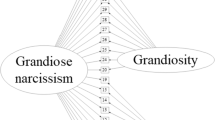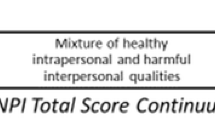Abstract
The Narcissistic Personality Inventory (NPI) traditionally has been administered using 40 pairs of items with a forced-choice response format. However, recent NPI research indicates that it may be advantageous to administer only the item from each pair that is in the narcissistic, keyed direction (i.e., using a “single-stimulus” format) in conjunction with a Likert style response rating scale (Ackerman et al. 2016). This same research and other prior studies also suggest that the NPI items assess distinct grandiose narcissistic traits (e.g., manipulativeness, leadership), such that focusing solely on total scores for analyses may be problematic. We extend this previous work by examining the NPI’s factor structure and correlates in both clinically-oriented community (N = 700) and undergraduate (N = 527) samples when this measure is administered using a single-stimulus format and a Likert style rating scale. Our results indicated that five replicable NPI factors (i.e., Manipulativeness, Grandiose Fantasies, Vanity, Leadership/Authority, Superiority) could be identified across samples. Subscales modeling these factors showed distinctive patterns of personality and psychopathology relations. For example, some subscales (e.g., Leadership/Authority, Superiority) showed strong positive relations with agentic aspects of extraversion and robust negative relations with neuroticism, but other subscales (e.g., Manipulativeness, Grandiose Fantasies) showed comparatively weaker associations with these personality traits. These results highlight a potentially more useful administration format for the NPI, and also underscore need to consider the distinctive nature of NPI subscales in future research using this measure.
Similar content being viewed by others
References
Ackerman, R. A., Witt, E. A., Donnellan, M. B., Trzesniewski, K. H., Robins, R. W., & Kashy, D. A. (2011). What does the narcissistic personality inventory really measure? Assessment, 18, 67–87.
Ackerman, R. A., Donnellan, M. B., Roberts, B. W., & Fraley, R. C. (2016). The effect of response format on the psychometric properties of the narcissistic personality inventory: Consequences for item meaning and factor structure. Assessment, 23, 203–220.
Arditte, K. A., Çek, D., Shaw, A. M., & Timpano, K. R. (2016). The importance of assessing clinical phenomena in mechanical turk research. Psychological Assessment, 28, 684–691.
Boldero, J. M., Bell, R. C., & Davies, R. C. (2015). The structure of the narcissistic personality inventory with binary and rating scale items. Journal of Personality Assessment, 97, 626–637.
Cain, N. M., Pincus, A. L., & Ansell, E. B. (2008). Narcissism at the crossroads: Phenotypic description of pathological narcissism across clinical theory, social/personality psychology, and psychiatric diagnosis. Clinical Psychology Review, 28, 638–656.
Corry, N., Merritt, R. D., Mrug, S., & Pamp, B. (2008). The factor structure of the narcissistic personality inventory. Journal of Personality Assessment, 90, 593–600.
Emmons, R. A. (1984). Factor analysis and construct validity of the narcissistic personality inventory. Journal of Personality Assessment, 48, 291–300.
Everett, J. E. (1983). Factor comparability as a means of determining the number of factors and their rotation. Multivariate Behavioral Research, 18, 197–218.
Everett, J. E., & Entrekin, L. V. (1980). Factor comparability and the advantages of multiple group factor analysis. Multivariate Behavioral Research, 2, 165–180.
Few, L. R., Miller, J. D., Rothbaum, A., Meller, S., Maples, J., Terry, D. P., Collins, B., & MacKillop, J. (2013). Examination of the section III DSM-5 diagnostic system for personality disorders in an outpatient clinical sample. Journal of Abnormal Psychology, 122, 1057–1069.
Finn, S. E. (1986). Structural stability of the MMPI in adult males. Journal of Consulting and Clinical Psychology, 54, 703–707.
Foster, J. D., Shiverdecker, L. K., & Turner, I. N. (2016). What does the narcissistic personality inventory measure across the total score continuum? Current Psychology, 35, 207–219.
Glover, N., Miller, J. D., Lynam, D. R., Crego, C., & Widiger, T. A. (2012). The five-factor narcissism inventory: A five-factor measure of narcissistic personality traits. Journal of Personality Assessment, 94, 500–512.
Gorsuch, R. L. (1983). Factor analysis (2nd ed.). Hillsdale: Erlbaum.
Jones, D. N., & Paulhus, D. L. (2014). Introducing the short dark triad (SD3): A brief measure of the dark personality traits. Assessment, 21, 28–41.
Krizan, Z., & Herlache, A. D. (2018). The narcissism spectrum model: A synthetic view of narcissistic personality. Personality and Social Psychology Review, 22, 3–31.
Krueger, R. F., Derringer, J., Markon, K. E., Watson, D., & Skodol, A. E. (2012). Initial construction of a maladaptive personality trait model and inventory for DSM–5. Psychological Medicine, 42, 1879–1890.
Maples, J. L., Guan, L., Carter, N. T., & Miller, J. D. (2014a). A test of the international personality item pool representation of the revised NEO personality inventory and development of a 120-item IPIP-based measure of the five-factor model. Psychological Assessment, 26, 1070–1084.
Maples, J. L., Lamkin, J., & Miller, J. D. (2014b). A test of two brief measures of the dark triad: The dirty dozen and short dark triad. Psychological Assessment, 26, 326–331.
McCredie, M. N., & Morey, L. C. (2019). Who are the turkers? A characterization of mturk workers using the personality assessment inventory. Assessment, 26, 759–766.
Miller, J. D., Lynam, D. R., Hyatt, C. S., & Campbell, K. W. (2017). Controversies in narcissism. Annual Review of Clinical Psychology, 13, 1–25.
Miller, J. D., Gentile, B., Carter, N. T., Crowe, M., Hoffman, B. J., & Campbell, K. W. (2018). A comparison of the nomological networks associated with forced-choice and Likert formats of the narcissistic personality inventory. Journal of Personality Assessment, 100, 259–267.
O’Connor, B. P. (2000). SPSS and SAS programs for determining the number of components using parallel analysis and Velicer’s MAP test. Behavior Research Methods, Instruments, & Computers, 32, 396–402.
Patrick, C. J., Kramer, M. D., Krueger, R. F., & Markon, K. E. (2013). Optimizing efficiency of psychopathology assessment through quantitative modeling: Development of a brief form of the externalizing spectrum inventory. Psychological Assessment, 25, 1332–1348.
Paulhus, D. L. (2001). Normal narcissism: Two minimalist accounts. Psychological Inquiry, 12(4), 228–230.
Paulhus, D. L., & Williams, K. M. (2002). The dark triad of personality: Narcissism, machiavellianism, and psychopathy. Journal of Research in Personality, 36(6), 556–563.
Pincus, A. L., & Lukowitsky, M. R. (2010). Pathological narcissism and narcissistic personality disorder. Annual Review of Clinical Psychology, 6, 421–446.
Pincus, A. L., Ansell, E. B., Pimentel, C. A., Cain, N. M., Wright, A. G. C., & Levy, K. N. (2009). Initial construction and validation of the pathological narcissism inventory. Psychological Assessment, 21, 365–379.
Raskin, R. N., & Hall, C. S. (1979). A narcissistic personality inventory. Psychological Reports, 45, 590.
Raskin, R., & Terry, H. (1988). A principal-components analysis of the narcissistic personality inventory and further evidence of its construct validity. Journal of Personality and Social Psychology, 54, 890–902.
Stanton, K., & Zimmerman, M. (2018). Clinician ratings of vulnerable and grandiose narcissistic features: Implications for an expanded narcissistic personality disorder diagnosis. Personality Disorders: Theory, Research, and Treatment, 9, 263–272.
Stanton, K., Daly, E., Stasik-O’Brien, S. M., Ellickson-Larew, S., Clark, L. A., & Watson, D. (2017). An integrative analysis of the narcissistic personality inventory and hypomanic personality scale: Implications for construct validity. Assessment, 24, 695–711.
Stanton, K., McArtor, D. B., & Watson, D. (2019). Parsing the hypomanic personality: Explicating the nature of specific dimensions defining mania risk. Assessment, 26, 492–507.
Timmerman, M. E., & Lorenzo-Seva, U. (2011). Dimensionality assessment of ordered polytomous items with parallel analysis. Psychological Methods, 16, 209–220.
Velicer, W. F. (1976). Determining the number of components from the matrix of partial correlations. Psychometrika, 41, 321–327.
Watson, D., O’Hara, M. W., Naragon-Gainey, K., Koffel, E., Chmielewski, M., Kotov, R., et al. (2012). Development and validation of new anxiety and bipolar symptom scales for an expanded version of the IDAS (the IDAS-II). Assessment, 19, 399–420.
Weaver, B., & Wuensch, K. L. (2013). SPSS and SAS programs for comparing Pearson correlations and OLS regression coefficients. Behavioral Research Methods, 45, 880–895.
Wetzel, E., Roberts, B. W., Fraley, R. C., & Brown, A. (2016). Equivalence of narcissistic personality inventory constructs and correlates across scoring approaches and response formats. Journal of Research in Personality, 61, 87–98.
Wright, A. G. C., & Edershile, E. A. (2018). Issues resolved and unresolved and pathological narcissism. Current Opinion in Psychology, 21, 74–79.
Wright, A. G. C., Lukowitsky, M. R., Pincus, A. L., & Conroy, D. E. (2010). The higher order factor structure and gender invariance of the pathological narcissism inventory. Assessment, 17, 467–483.
Wright, A. G. C., Thomas, K. M., Hopwood, C. J., Markon, K. E., Pincus, A. L., & Krueger, R. F. (2012). The hierarchical structure of DSM-5 pathological personality traits. Journal of Abnormal Psychology, 121, 951–957.
Funding
This study was partially funded by University of Notre Dame Institute for Scholarship in the Liberal Arts.
Author information
Authors and Affiliations
Corresponding author
Ethics declarations
Conflict of Interest
Matthew F. D. Brown, Kasey Stanton and David Watson declare that they have no conflict of interest.
Informed Consent
Informed consent was obtained from all individual participants included in this study.
Ethical Standards
This research received approval from the University of Notre Dame Institutional Review Board. All procedures performed in studies involving human participants were in accordance with the ethical standards of the institutional and/or national research committee and with the 1964 Helsinki declaration and its later amendments or comparable ethical standards.
Additional information
Publisher’s Note
Springer Nature remains neutral with regard to jurisdictional claims in published maps and institutional affiliations.
Rights and permissions
About this article
Cite this article
Brown, M.F.D., Stanton, K. & Watson, D. Replicable Factor Structure and Correlates of an Alternate Version of the Narcissistic Personality Inventory. J Psychopathol Behav Assess 42, 69–85 (2020). https://doi.org/10.1007/s10862-020-09790-y
Published:
Issue Date:
DOI: https://doi.org/10.1007/s10862-020-09790-y




